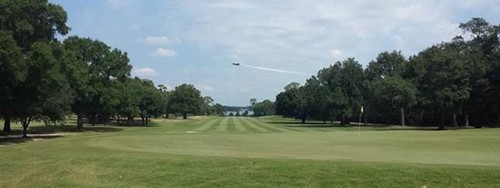
For Immediate Release
Tuesday, November 15, 2016
Contact: Meredith Beatrice,
850.245.6522
A.C. Read Golf Club Featured as Florida Historic Golf Trail Course of the Month
Tallahassee –
Secretary of State Ken Detzner announced today that the A.C. Read Golf Club, located at the Naval Air Station Pensacola in Escambia County, has been chosen as the featured course on the Florida Historic Golf Trail for the month of November.
“In commemoration of Veterans Day this November, we honor those who have served in the United States military and are pleased to feature the historic A.C. Read Golf Club as a partner on the Florida Historic Golf Trail,” said Secretary of State Ken Detzner. “With terrific views along Bayou Grande, this golf course has been part of the Naval Air Station Pensacola since World War II, providing service members, their families and the public a challenging golf course in a beautiful setting.”

Image Courtesy of A.C. Read Golf Club
Naval Air Station (NAS) Pensacola is known as the "Cradle of Naval Aviation" and occupies over 5,000 acres in Northwest Florida. In 1942, NAS Pensacola constructed an 18-hole golf course to provide recreational activity for the soldiers stationed there. The golf course is named in honor of Albert Cushing Read, an avid golfer and graduate of the first aviator class at Naval Air Station Pensacola in 1915.
Today the A.C. Read Golf Club is a public 27-hole golf complex consisting of three 9-hole courses that are played in 18-hole combinations (Bayou, Lakeview, and Bayview). Each 9-hole course features three sets of tees playing from 2,600 to 3,200 yards and the 18-hole combinations play from 5,400 to 6,600 yards. The A.C. Read Golf Club also includes an 18-hole, par-60 executive golf course featuring three sets of tees playing from 4,000 to 4,300 yards. The original 18-hole golf course has been incorporated into portions of the entire golf complex.
"We are thrilled to be chosen as this month's featured course on the Florida Historic Golf Trail," said Steve Bobe, PGA, and General Manager of A.C. Read Golf Club on board Naval Air Station Pensacola. “Known as the ‘Cradle of Naval Aviation’ our incredible legacy is strengthened by a multi-million dollar Jerry Pate redesign in 2003. We are also the home of the world famous Blue Angels. Check the practice schedule and come enjoy your own personal air show right over your head as you play!”
For more information about the A.C. Read Golf Club or the Florida Historic Golf Trail program visit A.C. Read Golf Club, Florida Historic Golf Trail or Facebook.com/FloridaHistoricGolfTrail.
# # #
About The Florida Historic Golf Trail
Florida's golf history, recognized as one of the oldest in the nation, dates back to the 1890s when a number of early courses were created along with the development of railroads and hotels in the state. The Florida Historic Golf Trail is a collection of more than 50 historic, publicly accessible golf courses throughout the state that can still be played on today. Through the Florida Historic Golf Trail, golfers can play on courses designed by world-class architects and played by famous golfers such as Bobby Jones, Walter Hagen, Gene Sarazen, Babe Zaharias, Arnold Palmer and Jack Nicklaus. Information about the history and current day contact information for each partner course can be found at FloridaHistoricGolfTrail.com. Find the historic course near you and Come Play on History!
About The Division of Historical Resources
The Florida Department of State’s Division of Historical Resources (DHR) is responsible for preserving and promoting Florida’s historical, archaeological, and folk culture resources. DHR directs historic preservation efforts throughout the state in cooperation with state and federal agencies, local governments, private organizations, and individuals. The director of DHR serves as the State Historic Preservation Officer, acting as the liaison with the national historic preservation program conducted by the National Park Service. The Division is comprised of two Bureaus or major program areas: archaeological research and historic preservation. For more information, visit flheritage.com.
